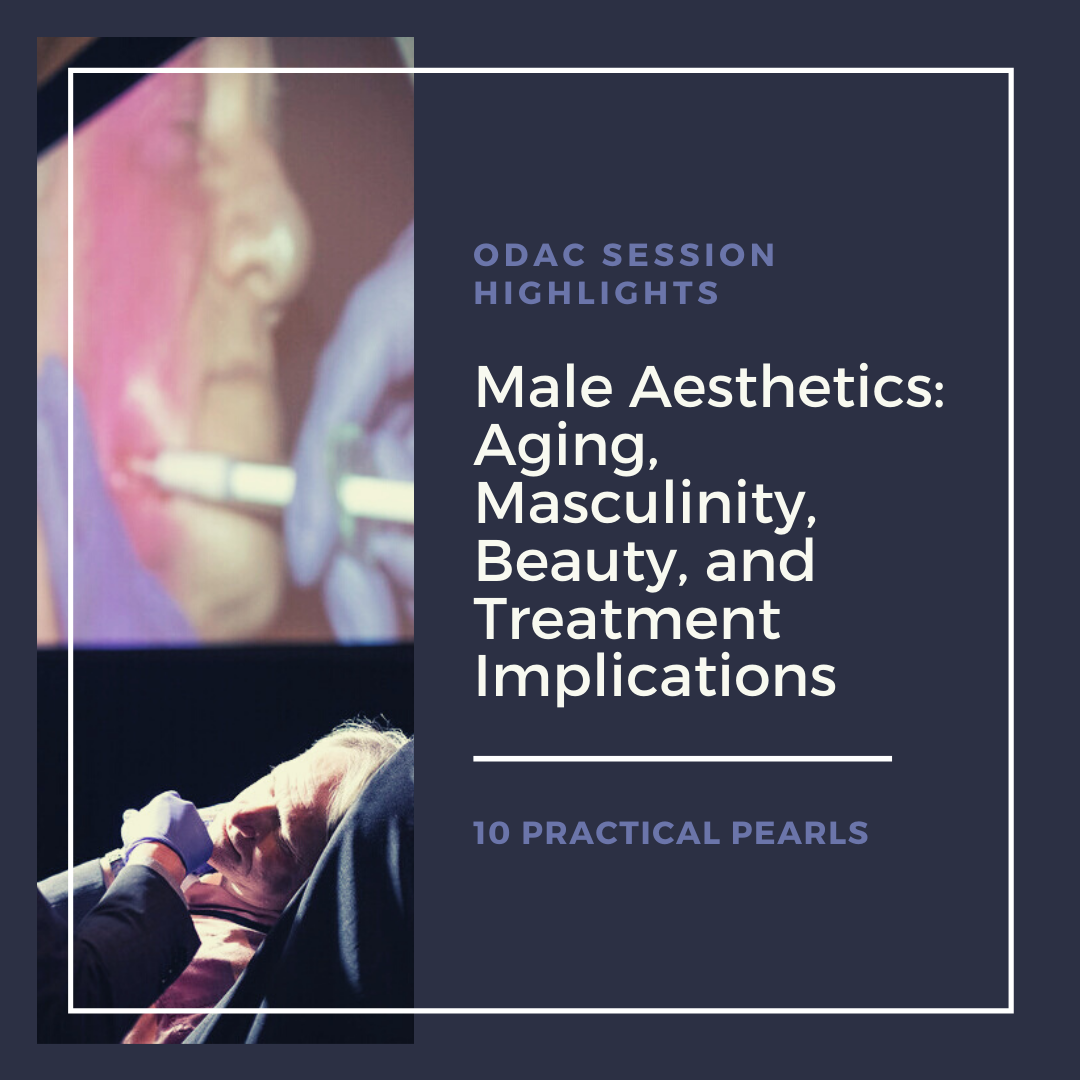Since the advent of the phrase “metrosexual” during the mid-1990s, men have slowly leaned into indulging their desire to become more beautiful. First, they started being more meticulous about their manscaping, some then began to dabble in makeup such as guyliner (ok one could argue that this was a thing during glam rock, but I’m talking about everyday dudes here), while others pursued new frontiers in fashion such as meggins, mewelery, and carrying murses. In the realm of aesthetic dermatology, we have witnessed the advent of terms such as brotox and yes, even…scrotox. And that these terms now exist makes sense, since men comprise a growing segment of aesthetic patients.
At the 2020 Orlando Dermatology and Aesthetics Conference, Dr. Terrence Keaney, who is the co-founder of SkinDC, a private practice in the Washington, DC area, Assistant Clinical Professor at George Washington University and Howard University Departments of Dermatology, and Director of the Laser and Lipoatrophy Clinic at the Washington, DC, Veterans Administration (VA) Hospital, gave a lecture entitled “Male Aesthetics: Aging, Masculinity, Beauty, and Treatment Implications,” which provided 10 extremely valuable pearls to consider when working with the male aesthetic patients. These pro tips are invaluable since the same consultation and treatment techniques we have for the female aesthetic patient cannot be directly applied to men.
This post will provide insights into how men are unique in regards to:
-
- Facial anatomy
- Aging
- Their main areas of aesthetic concern
- Laser treatments
- Body contouring
But first, let me share a few of my “A-ha” moments from Dr. Keaney’s talk, in the hope that they will entice you to read on…
-
- Ever wonder why that dude on your favorite dating app who claims to be 31 actually looks like he is 57? He is either lying about his age (very possible), or he has succumbed to some of the unique characteristics of the male aging process. Read on to learn what these are!
- If you have a male patient who is skittish about crossing over into the aesthetic realm, you can gently start the conversation by focusing on 3 concerns that he will likely have about his appearance. You know you’re curious about what these are, so read on!
- A male cosmetic consult patient comes to you complaining that he “looks tired.” Need help decoding what he is really trying to say? You’ll have to keep reading to find out!
 There are key differences in facial anatomy between men and women.
There are key differences in facial anatomy between men and women.
Compared to women, men’s faces tend to be more square. This difference is attributable to a high, wide forehead, flatter cheeks that project more laterally than medially, wider jaw and chin, and eyebrows that sit lower along a more prominent supraorbital ridge. In contrast, the female face is more heart-shaped, with more medial cheek projection, a smaller, more convex forehead, and lower face tapering.
 Men age poorly…and differently.
Men age poorly…and differently.
In general, men appear older than their stated age compared to women, for a number of reasons. Men begin to show signs of aging around a decade before women, and in concert with a decline in testosterone that begins in the late 20s, tend also to exhibit a linear trend towards facial volume loss and overall contour changes. These changes lead to the square male facial shape approaching a more trapezoidal appearance. In contrast, women experience a sudden hormonal shift during the perimenopausal period that changes the appearance of a once heart-shaped face to one that is more square. That which surrounds the face also affects perception of age. Studies have shown that men with receding hairlines are perceived to be, on average, around 5 years older than they actually are. To keep the punishment coming, men do not produce as many endogenous cutaneous antioxidants as women, and they have a different response to UV light. From a behavioral standpoint, men are both less likely to address cosmetic concerns at an early stage and to adopt sun-protective behaviors.
There are important differences in male facial anatomy that one should be aware of, as they bear upon neuromodulator placement. Men tend to exhibit a “U” contraction pattern in the glabella that results from greater involvement of the procerus. They also tend to create a “lower fan” wrinkle pattern at the lateral canthi as a result of greater recruitment of cheek elevators such as zygomaticus major. It is therefore important to counsel your male patients with lower fan wrinkles that it may not be possible to fully eradicate them because doing so will compromise their ability to smile normally.
 The definition of “male beauty” varies widely.
The definition of “male beauty” varies widely.
Take a look at who the most sought after male celebrities are, and you will see that there is no uniform consensus on male beauty. Listen to what your patient is looking to achieve, and work with them to devise a treatment plan that will deliver what they desire, within reason.
 Men care about aging…but differently.
Men care about aging…but differently.
Pro tip: The top 3 male aesthetic concerns are the hairline, periocular region, and jawline.
 When a male patient complains about “looking tired,” this is code that he is concerned about his eyes.
When a male patient complains about “looking tired,” this is code that he is concerned about his eyes.
Very often this concern can be addressed with neuromodulators, but it also presents a great opportunity to broach the topic of soft tissue fillers, especially in the tear troughs.
 Know where the male cheek apex is.
Know where the male cheek apex is.
The cheek apex, where the maximum light reflex is located, is more inferior and medial on the male cheek, in contrast to a more superolateral position in women. This is important to be aware of since it dictates where you will want to place your filler when revolumizing the midface.
 Don’t forget to address the lower face.
Don’t forget to address the lower face.
As stated above, the jawline is one of the top 3 areas of cosmetic concern in men. Men may seek to achieve a wider or more defined jawline with the use of soft tissue filler. The chin can also be augmented in this manner, keeping in mind that its width should extend to the oral commissures (to the medial canthi in women), and that that anterior projection of the lower chin should be in line with the lower lip (whereas in women it should be 1-2 mm behind it). Finally, remember that submental fat might obscure all of your impressive handiwork along the chin and jawline, so address this too if necessary!
 The best way to lose a male aesthetic patient is to inadvertently peak his eyebrow when using neuromodulators.
The best way to lose a male aesthetic patient is to inadvertently peak his eyebrow when using neuromodulators.
Respect the anatomy of the male eyebrow, which tends to sit flat and low. When Dr. Keaney treats the frontalis muscle with neuromodulator, his first two injection points are placed where he does not want the eyebrow to peak. Also note that treatment of the male glabellar complex and lateral canthi often requires higher doses of neuromodulator, which creates the potential for diffusion to adjacent musculature, and consequently an opportunity for the unopposed lateral fibers of the frontalis to pull the eyebrow superiorly. To prevent this from happening, Dr. Keaney will often place very small aliquots of neuromodulator (0.5 units, for example) where he does not want the eyebrow to peak, even if he isn’t treating the forehead at all.
 Men love technology.
Men love technology.
Lasers can often serve as a cosmetic gateway for men, but there are certain considerations that are unique to men that must be kept in mind. Men have a thicker epidermis, which creates a theoretical risk of increased laser scatter, as well as increased cutaneous vasculature in the lower face to support beard growth. Laser hair removal in the beard area, where hair tends to be thicker and darker, may also require a lower fluence and longer pulse duration compared to other areas of the body. Finally, men have a thicker dermis that can accommodate more tattoo pigment, in the case of gentlemen who have opted to get inked. Tattoo removal therefore can pose a challenge, often requiring more sessions to address a larger amount of pigment that extends more deeply into the dermis.
 There are a few important considerations for body contouring in men.
There are a few important considerations for body contouring in men.
Men tend to accumulate more visceral fat, which is not amenable to noninvasive body contouring. Paradoxical adipose hyperplasia resulting from cryolipolysis is also more common in men, so be very cautious when treating male breasts with this modality. Finally, male liposuction can also pose a therapeutic challenge, because the fibrous septae of their adipose tissue are oriented more parallel to the skin’s surface, rather than perpendicular.
So, how are you bringing male aesthetic patients into your practice? What do you find their most common concerns to be? Do you have any pearls of your own for the use of neuromodulators and soft tissue fillers in the male aesthetic patient?
Please tell us all about it in the comments at the end of this post, and on Instagram @nextstepsinderm!
This information was presented by Dr. Terrence Keaney at the 17th Annual ODAC Dermatology, Aesthetic and Surgical Conference held January 17–20, 2020 in Orlando, FL. The above highlights from his lecture were written and compiled by Dr. Kimberly Huerth, Chief Dermatology Resident at Howard University, and one of the 7 residents selected to participate in the Sun Young Dermatology Leader Mentorship Program (a program supported by an educational grant from Sun Pharmaceutical Industries,
Did you enjoy this post? Find more on Aesthetic Dermatology here.


